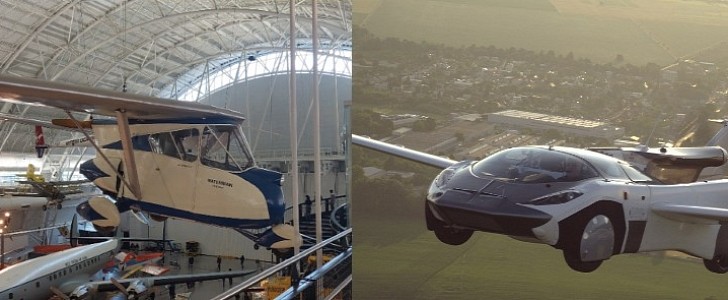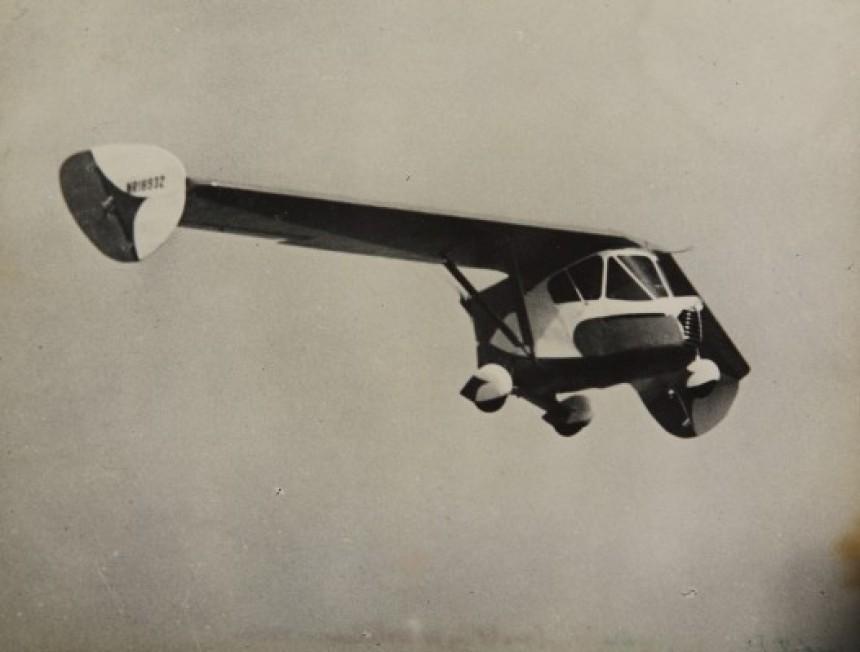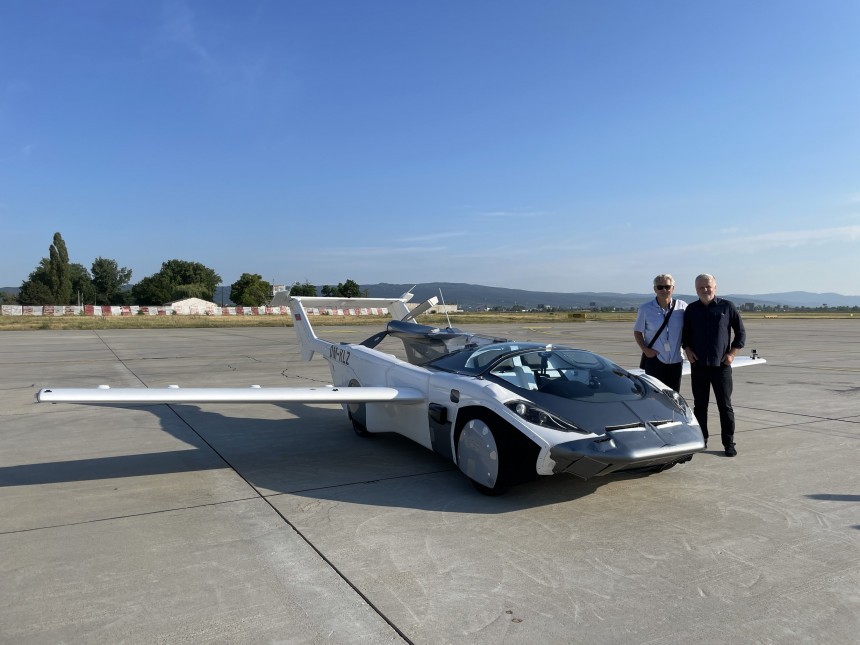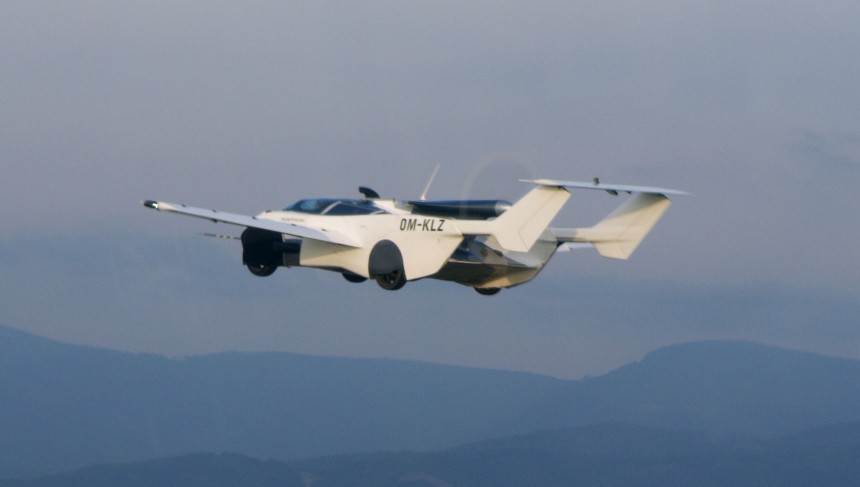We human beings are stubborn folk, soaring to the skies in our newfangled flying machines, against the will of the Lord Almighty.
But since not being born with wings and beaks isn't a hindrance to manned flight anymore, why not merge automobiles and airplanes into something that can be both? More brilliant engineers have tried to answer that question than we could ever bring together in a standard-length feature.
But there are a handful of Slovakian engineers who think the time of the flying car may finally be at hand. All thanks to the Klein Vision AirCar, a radical new airplane/automobile hybrid that appears to have been constructed with about 50% automotive and 50% aeronautical components.
But what exactly does this BMW-engined chimera possess that failed flying cars of the past did not? In short, what about the AirCar is so revolutionary that it suddenly makes the concept of a flying automobile viable? To try and answer this question, let's have a look at a flying car from the distant past we've already featured recently, the Waterman Arrowbile.
Perhaps the very first successful attempt at a flying car, the Arrowbile was the brainchild of American engineering savant Waldo Waterman. A man who had the very same ambitions as Klein Vision several decades before the parents of the AirCar's design team were even born.
The Slovak Republic, where the AirCar was constructed, was 54 or so years away from existence in 1937. Just to give you an idea of how long mankind's been trying and failing to make a successful flying car. No pun intended, but time really does fly, doesn't it?
According to official info from Klein Vision, the AirCar Prototype 1 is powered by a 160 horsepower BMW engine mounted in the rear of the vehicle. The six-cylinder Studebaker engine found in later models of the Waterman Arrowbile made 60 horsepower less. That's a fair bit less power out of either machine than you may have expected, but lightness over raw power is the name of the game in a serviceable aircraft.
The AirCar can cruise at a maximum of 118 mph (190 kph) with a maximum currently achieved altitude of 8,200 feet (2,500 meters). For comparison, the Smithsonian Institution, which currently owns the only surviving Waterman Arrowbile, claims it could cruise at 120 mph (190 kph) at a maximum altitude of at most 10,000 feet (3,048 meters).
On the surface, at least, it appears there's not much difference between the AirCar and Arrowbile, at least as far as raw performance is concerned. Even from a strictly aesthetic comparison, there are visible similarities between the two.
The rudder configuration on the Arrowbile sits at either end of the long, slightly swept-back wings. On the AirCar, these twin rudders sit at the end of a twin-boom arrangement that contracts into a holding chamber while in automotive mode, as do the wings.
Like the Arrowbile, the AirCar's propeller is mounted behind the cockpit in a pusher configuration, as opposed to the more conventional "pull-me" configuration common on most private-owned leisure aircraft like Cessna 172s. It's a design cue Waldo Waterman himself would have approved of, no doubt.
But when we delve into the nitty-gritty, we can start to see the signs that the AirCar may have the solutions to problems engineers like Waldo Waterman himself couldn't solve. Firstly, the Arrowbile's wings were cumbersome and bulky, especially at highway speeds. The highest anyone dared drive it was 70 mph (113 kph).
More significant still, the Arrowbile was constructed with what was, in the period, very good quality aeronautical aluminum. In its day, this material was perfectly acceptable. But we've come a long way on that front. The original AirCar prototype is reported to only weigh 2,204 lbs (1,000 kg). Only a few hundred pounds more than the much less sophisticated Arrowbile. All thanks to the extensive use of composite materials in the airframe.
This lightweight allows the aeronautical control surfaces like the wings and tail to hydraulically stow away while in road use without overwhelming current hydraulic technology capabilities. It's a technological advancement that was unthinkable in Waldo Waterman's day.
Arrowbiles never sold in enough numbers to know how it would have withstood repeated takeoffs, landings, and highway cruising. In the modern-day, aircraft can't even take to the skies without earning airworthiness certifications the Klein Vision team worked for hundreds of thousands of hours to acquire.
If the prototype AirCar can pass very stringent European standards for air safety, chances are good for it to pass auto safety tests with flying colors. Safe to say, safety requirements were a fair bit less stringent eight decades ago than they are today, if even existent at all.
So then, even if their performance figures hardly vary at all, the real difference between the Klein Vision AirCar and the Waterman Arrowbile is refinement on a scale that would have astonished engineers of long ago. In its defense, the Arrowbile was indeed a groundbreaking technology demonstrator.
But we don't think anyone in their right might would ever fly in one, lest the wings snapped off as so many flying car concepts have happened before. It's a pretty safe bet such a disaster won't happen in an AirCar. If that kind of guarantee takes a century of development to achieve, then frankly, it's time well spent.
But there are a handful of Slovakian engineers who think the time of the flying car may finally be at hand. All thanks to the Klein Vision AirCar, a radical new airplane/automobile hybrid that appears to have been constructed with about 50% automotive and 50% aeronautical components.
But what exactly does this BMW-engined chimera possess that failed flying cars of the past did not? In short, what about the AirCar is so revolutionary that it suddenly makes the concept of a flying automobile viable? To try and answer this question, let's have a look at a flying car from the distant past we've already featured recently, the Waterman Arrowbile.
Perhaps the very first successful attempt at a flying car, the Arrowbile was the brainchild of American engineering savant Waldo Waterman. A man who had the very same ambitions as Klein Vision several decades before the parents of the AirCar's design team were even born.
According to official info from Klein Vision, the AirCar Prototype 1 is powered by a 160 horsepower BMW engine mounted in the rear of the vehicle. The six-cylinder Studebaker engine found in later models of the Waterman Arrowbile made 60 horsepower less. That's a fair bit less power out of either machine than you may have expected, but lightness over raw power is the name of the game in a serviceable aircraft.
The AirCar can cruise at a maximum of 118 mph (190 kph) with a maximum currently achieved altitude of 8,200 feet (2,500 meters). For comparison, the Smithsonian Institution, which currently owns the only surviving Waterman Arrowbile, claims it could cruise at 120 mph (190 kph) at a maximum altitude of at most 10,000 feet (3,048 meters).
On the surface, at least, it appears there's not much difference between the AirCar and Arrowbile, at least as far as raw performance is concerned. Even from a strictly aesthetic comparison, there are visible similarities between the two.
Like the Arrowbile, the AirCar's propeller is mounted behind the cockpit in a pusher configuration, as opposed to the more conventional "pull-me" configuration common on most private-owned leisure aircraft like Cessna 172s. It's a design cue Waldo Waterman himself would have approved of, no doubt.
But when we delve into the nitty-gritty, we can start to see the signs that the AirCar may have the solutions to problems engineers like Waldo Waterman himself couldn't solve. Firstly, the Arrowbile's wings were cumbersome and bulky, especially at highway speeds. The highest anyone dared drive it was 70 mph (113 kph).
More significant still, the Arrowbile was constructed with what was, in the period, very good quality aeronautical aluminum. In its day, this material was perfectly acceptable. But we've come a long way on that front. The original AirCar prototype is reported to only weigh 2,204 lbs (1,000 kg). Only a few hundred pounds more than the much less sophisticated Arrowbile. All thanks to the extensive use of composite materials in the airframe.
Arrowbiles never sold in enough numbers to know how it would have withstood repeated takeoffs, landings, and highway cruising. In the modern-day, aircraft can't even take to the skies without earning airworthiness certifications the Klein Vision team worked for hundreds of thousands of hours to acquire.
If the prototype AirCar can pass very stringent European standards for air safety, chances are good for it to pass auto safety tests with flying colors. Safe to say, safety requirements were a fair bit less stringent eight decades ago than they are today, if even existent at all.
So then, even if their performance figures hardly vary at all, the real difference between the Klein Vision AirCar and the Waterman Arrowbile is refinement on a scale that would have astonished engineers of long ago. In its defense, the Arrowbile was indeed a groundbreaking technology demonstrator.














